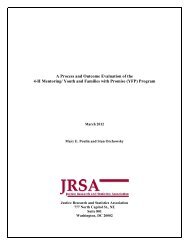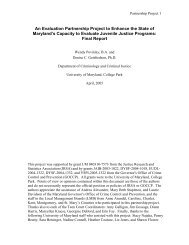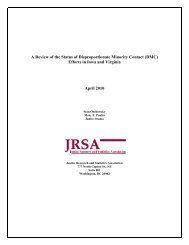Juvenile Justice System and Risk Factor Data - Illinois Criminal ...
Juvenile Justice System and Risk Factor Data - Illinois Criminal ...
Juvenile Justice System and Risk Factor Data - Illinois Criminal ...
You also want an ePaper? Increase the reach of your titles
YUMPU automatically turns print PDFs into web optimized ePapers that Google loves.
Detoxification<br />
Discretionary transfer<br />
Dispositional hearing<br />
(disposition)<br />
Disproportionate<br />
minority confinement<br />
Disproportionate<br />
minority contact (DMC)<br />
Disproportionate<br />
Representation index<br />
(DRI)<br />
Dropouts<br />
Drug offenses<br />
Excluded jurisdiction<br />
Extended jurisdiction<br />
juvenile prosecution<br />
Family group<br />
conferencing<br />
Forcible felony<br />
Formal probation<br />
Foster home<br />
The process of withdrawing a person from a specific psychoactive substance in<br />
a safe <strong>and</strong> effective manner.<br />
A transfer of a minor 13 years of age or older to adult court for criminal<br />
prosecution when a motion has been filed by the state’s attorney <strong>and</strong> the judge<br />
finds that there is probable cause to believe the allegations in the motion to be<br />
true <strong>and</strong> it is not in the best interest of the public to proceed under the <strong>Juvenile</strong><br />
Court Act.<br />
Hearing to determine whether a minor should be adjudged to be a ward of the<br />
court <strong>and</strong> to determine what order of disposition should be made. Effective<br />
January 1, 1999, the term “sentencing hearing” replaced “dispositional hearing”<br />
in delinquency cases.<br />
The over-representation of minority youth in secure juvenile facilities compared<br />
to minority youth representation in the general population.<br />
The over-representation of minority youth involved in the juvenile justice system<br />
at any given stage of the process compared to minority youth representation in<br />
the general population.<br />
Compares the percentage of all youth who are of a particular minority group at<br />
one stage of the juvenile justice process to that minority group’s representation<br />
at the previous stage.<br />
The number of students, grades 9-12, who were removed from the school<br />
district roster during the school year for any reason other than death, extended<br />
illness, graduation, transfer to another school, or expulsion.<br />
Violations of the following public acts regarding illegal drugs <strong>and</strong> liquor<br />
violations by minors: Cannabis Control Act, Controlled Substances Act,<br />
Hypodermic Syringes <strong>and</strong> Needles Act, Drug Paraphernalia Act, <strong>and</strong> Liquor<br />
Control Act.<br />
Exclusion from the jurisdiction of the juvenile court by age or crime committed.<br />
A juvenile prosecution where a juvenile, if found delinquent, receives a juvenile<br />
<strong>and</strong> an adult sentence with the adult sentence stayed pending satisfactory<br />
completion of the juvenile sentence. Should the juvenile not satisfactorily<br />
complete the juvenile sentence, the adult sentence will be imposed. See 705<br />
ILCS 405/5-810(4).<br />
Also called community, accountability, <strong>and</strong> restorative group conferences.<br />
Guided by a trained facilitator, the offender <strong>and</strong> victim along with members of<br />
their support systems, typically family members, share their feelings about the<br />
conflict or harm. An agreement is developed that describes what the offender<br />
must do to repair the harm.<br />
Violations of criminal law that include: treason, first degree murder, second<br />
degree murder, predatory criminal sexual assault of a child, aggravated arson,<br />
arson, aggravated kidnapping, kidnapping, aggravated battery resulting in great<br />
bodily harm, or other felony which involved the use or threat of physical force or<br />
violence. See 720 ILCS 5/2-8.<br />
The guidance, treatment, or regulation by a probation officer for the behavior of<br />
delinquent youth, after a court sentence. Youth adjudicated delinquent can be<br />
sentenced to probation for a maximum of five years or until age 21, whichever<br />
comes first.<br />
A form of non-secure custody, where youth are placed with licensed, private<br />
caregivers on a temporary basis.<br />
103

















